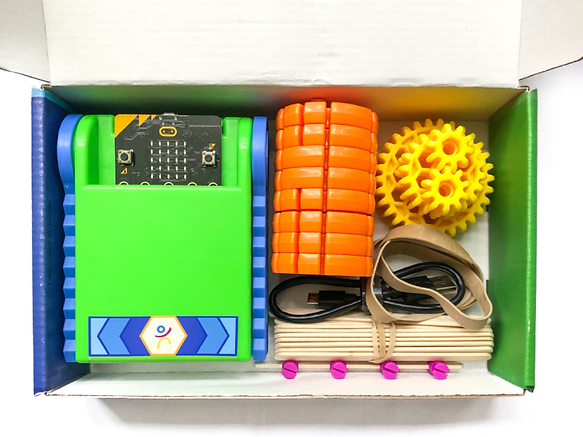Inspired by Visits to India, Two Brothers Started Trashbots to Make Robotics More Accessible
The idea for Trashbots came to Brothers and students Rohit and Sidharth Srinivasan after teaching at orphanages in India

To some, crumpled plastic water bottles, milk cartons, or popsicle sticks might seem like garbage, but to brothers and entrepreneurs Rohit and Sidharth Srinivasan, these common everyday items represent an opportunity for equitable STEM education. These and other common items provide the backbone for Trasshbots, the Srinivasan brothers’ affordable robotics platform for schools.
“The name came up from the idea that we wanted our products to be as accessible as trash,” Rohit says. “There's some negative connotations along with that, but what we really mean is things like a water bottle or milk carton or things that you find around you in the world. That's what real engineering is — real engineering is being able to find items and repurpose them to be able to build in the real world.”
Trashbots: The Inspiration for an Equitable Robotics Company

Rohit and Sidharth founded Trashbots while they were attending Westlake High School in Texas. They were inspired to create a more accessible robotics platform by their experiences volunteering to teach in India. “We’d been spending every winter break going and traveling to these Indian orphanages,” Sidharth says. “We'd be going and teaching them robotics, teaching them science activities, math activities.”
During those trips, they learned what some of the barriers to STEM education for many of those children were, and it often came down to price. Many robotics kits cost several hundred dollars per kit or more.
Rohit and Sidharth decided to solve this problem. They ultimately developed an affordable basic robotics kit that could be expanded using everyday items as common as trash. They also built accompanying programming software and developed a curriculum that teachers can use to guide their students.
“When we first started working on it, we simply were just kids who wanted to learn more about robotics and computer science,” Rohit says.
As the product took shape one of Trashbots’ first customers was the Eanes Independent School District where both brothers attended school. Rohit graduated by 2019, but Sidharth was still in school when his class utilized Trashbots. “Sidharth was in the class having to use Trashbots, despite being the creator of Trashbots himself, which is something we always look back on and think is really funny,” Rohit says.
Tools and ideas to transform education. Sign up below.
Affordable Hardware and Accessible Curriculum
The Trashbot robot kits are small, roughly book-size devices equipped with multiple LEDs, six sensors, two motors, and a speaker. However, what makes Trashbot kits special is not what they come out of the box with, but how students can customize each one using everyday objects.
The hardware is only the first part of the platform Rohit and Sidharth have designed for Trashbots. The second component is the software Trashbots utilize. “We have developed this block-based software [that] helps kids learn about programming concepts at a young age,” Sidharth says. “The third part is the curriculum. Our curriculum is all web-based and posted in the learning management system. We have more than 100 hours of curriculum that spans kindergarten all the way through 12th grade.”
Students and teachers benefit from easy-to-use, age-appropriate lesson plans that are geared at helping students learn STEM concepts as they get the most out of their Trashbot. The work repurposing everyday items to build their robots also more closely mirrors real-world engineering and supports hands-on problem-solving skills, the brothers say.
“In life, you are not always given a kit of parts to build everything perfectly,” Rohit says. “Instead, you’re often handed incomplete parts that you need to adjust in order to work. That’s where Trashbots came from.”
Erik Ofgang is a Tech & Learning contributor. A journalist, author and educator, his work has appeared in The New York Times, the Washington Post, the Smithsonian, The Atlantic, and Associated Press. He currently teaches at Western Connecticut State University’s MFA program. While a staff writer at Connecticut Magazine he won a Society of Professional Journalism Award for his education reporting. He is interested in how humans learn and how technology can make that more effective.

